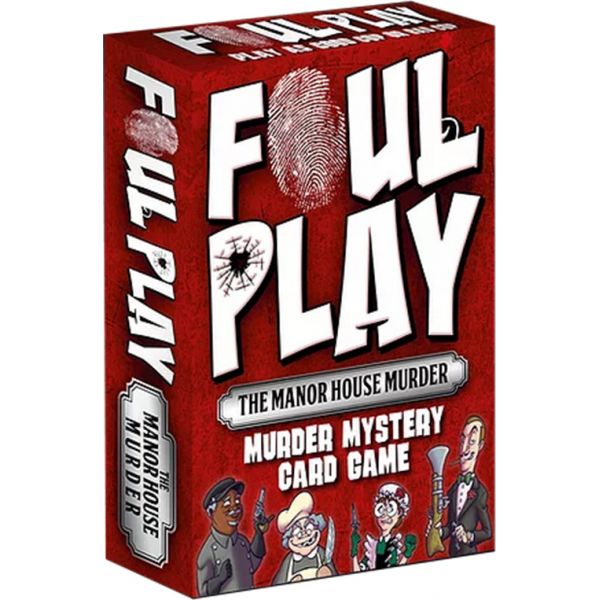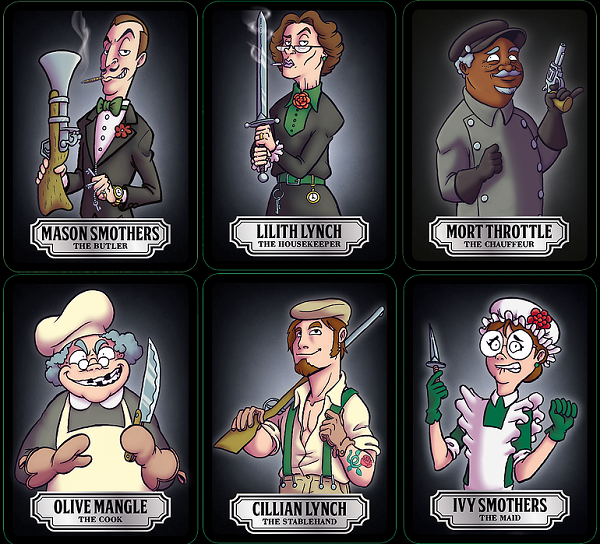Solve a Murder or Frame a Suspect in Foul Play

Will you be a good cop, putting the case together piece by piece until you capture the murderer? Or be a bad cop who doesn’t care who they accuse so long as it sticks?
Foul Play is a light deduction mystery card game, published by After Dark Murder Mystery. It comes with two different game modes to choose from, each focusing on a different element of the game.
Gameplay
The game has two modes: Good Cop and Bad Cop. For Good Cop, you separate out all the evidence cards. Cards come with three different colors of card backs, and there are five evidence cards for each color. You randomly take one evidence card of each card color and shuffle them into the deck while the rest are returned to the box.
Evidence cards include statements such as ‘the killer has grey hair’, ‘the killer wears a hat’, and ‘the victim was stabbed’.
Next, you lay out nine cards face-down in the center of the table. This is the crime scene. Each player is then dealt five cards. Finally, one card is placed on one side of the crime scene, face-down, to form the discard pile, and the rest of the deck is set to one side to be the draw pile.
On your turn you either choose one card to discard and then draw a new one, or play a card for its action and then draw a new one. When the draw pile runs out, the discard pile is shuffled and becomes the new draw pile.
Actions include stealing a card from another player’s hand, swapping a card with another player, looking at another player’s hand, forcing all players to reveal their cards to each other, or swapping a card from your hand with a card from the crime scene. There are also block cards in the deck, which opponents can use to stop you after you play a card but before you perform an action. In this case, the player who used the block card will also draw a new card into their hand.
Other cards you can hold are, of course, the evidence cards, red herring cards which do nothing and are best discarded, and suspect cards which show the name and occupation and a picture of the suspect.
During the course of the game, if you come across all three pieces of evidence, you will be able to deduce which suspect is the murderer. If you have the suspect in your hand, you may play it on your turn. Someone can use a block card to stop you accusing the suspect, in which case you take the suspect back into your hand and must wait for your next turn to try again. If you are not blocked, then you name the three pieces of evidence and accuse your suspect. The evidence is then checked. Assuming you didn’t make a mistake, you won the game. If you did make a mistake, you are out of the game. The other players will now know what the evidence cards are, so it is simply a race to see who can get the correct suspect card and make the accusation first.
In Bad Cop mode, you don’t care about catching the killer, only about making a good case. All the evidence cards are shuffled into the deck at the start. Set up is exactly the same, only each player starts with a hand of seven cards instead of five.
To win the game, you must collect in your hand a piece of evidence of each card color and the suspect they point to, before you can accuse that suspect. If a player uses a block to stop your accusation, then the blocker takes the suspect card (since you have the evidence that incriminates that suspect, they will not be able to accuse the suspect themselves). You can either attempt to get the suspect back, or start building a case against someone else.

Review
Foul Play is a combination of memory game and take-that, with a slight element of deduction. As you slowly narrow down the suspects based on the evidence cards, it does feel satisfying when you can dismiss a suspect or realize someone is a likely contender.
There’s a strong memory element to the Good Cop gameplay as you try to remember which cards in the crime scene you’ve already swapped out, and trying to keep in mind any evidence you’ve already seen.
Bad Cop leans more heavily into the take-that element, as you’re pushing to steal more cards and directly fighting over pieces of evidence. It’s about rolling with the cards you have and trying to figure out where your best chances lie. There is a little bit of memory involved in actions such as swapping a card with the crime scene, but it doesn’t play as significant a role.
Both rule sets do feel like fairly different games, which is impressive when dealing with only one deck of cards. While we preferred Good Cop, both modes were fun and both felt like they’d fit well with different types of game groups.
The rules are not presented in a great format. They’re printed on cards, in such a way that you have to jump back and forth between different cards in order to understand fully how to play the game mode you have chosen. It is also not made clear if cards are discarded face-up or face-down. The artwork on some of the action cards could also be a bit more exciting.
Overall, Foul Play is a clever little card game that takes up very little space, and is pretty easy to teach. The mystery theme is fun, there’s plenty of player interaction, and we liked how each mode favored a different side of the game.
Pros: Two game modes, enjoyable theme, player interaction
Cons: Rules are not presented well, some of the artwork could be improved
Disclosure: we received a complimentary review copy of this game.






